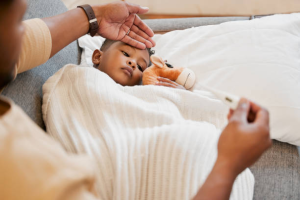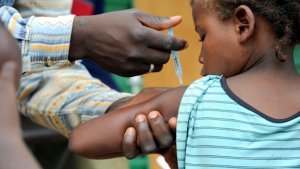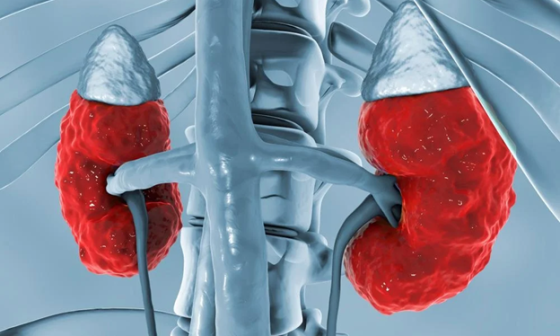Introduction
Childhood is an important period in human development, where a child grows and learns about their environment and how to interact with it. In daycare, child care, play centers, and schools children are constantly exposed to varying amounts of pathogens and disease-causing-organisms. Certain illnesses often affect children during this period due to their developing immune systems, as the immune system is not fully mature enough to combat certain infections and diseases.

Source: iStock
In Nigeria, childhood deaths are relatively common and largely preventable, Wellahealth is here to educate you and other parents on how to protect your children’s health against common childhood illnesses and diseases, so your children can reach their full potential as future leaders. We will discuss common childhood illnesses affecting Nigerian children and prevention tips in this article.
Common Childhood Illnesses
Malaria
Malaria is a protozoal infection spread by the parasite- female Anopheles mosquito. Malaria is one of the most common causes of sickness and mortality among children in Nigeria. Malaria can cause fever, chills, and anaemia. Severe cases can result in convulsions, coma, or even death.
Common Cold
A viral infection is often caused by over 200 viruses, most commonly the rhinovirus. The common cold is very easily spread to others. It’s often spread through airborne droplets that are coughed or sneezed into the air by the sick child. The droplets are then inhaled by another child. Furthermore, colds can also be spread when a sick child touches a surface (like a doorknob) that another child then touches. It is characterized by symptoms such as coughing, sore throat, runny nose, and sneezing. In schools and playgrounds, children contract this infection and spread it to other children and even their parents. Children in daycare and schools often suffer about 6-8 colds per year, symptoms are often self-limiting lasting up to 7-10 days, and do not cause death.
Respiratory Infections
Respiratory infections are common in childhood often caused by bacteria or viruses, a typical example is pneumonia. Pneumonia is one of the most common causes of Acute Respiratory Infection (ARI). It presents with fever, coughing, fast breathing, and breathing difficulties. Pneumonia can range in severity from minor colds to serious lung diseases that impair breathing.
Diarrheal Diseases
Diarrhoea is a symptom of bacterial, viral, or parasitic infections transmitted through the faecal-oral route like Cholera. One of the main causes of child death is diarrhoea, which is frequently caused by bacterial, viral, or parasitic organisms found in contaminated food or water. Fever, dehydration, and watery faeces are some of the symptoms. In extreme cases, it causes dehydration which can lead to death in children.
Typhoid Fever
Typhoid is a bacterial infection caused by salmonella typhi that spreads through contaminated food or drink, causing fever, headache, abdominal pain, and constipation or diarrhoea.
Skin Infections
Contagious skin infections like eczema, impetigo, and scabies, often affect children who have poor hygiene or share household items like towels with infected family members. They present with rashes, itching, blisters, and skin irritation.
Meningitis
Meningitis is the inflammation of the membranes (meninges) that surround the central nervous system (Brain and Spinal cord). Meningitis affects children in the northern part of Nigeria more commonly. Meningitis is caused by several species of viruses, fungi, parasites, and bacteria. It causes fever, stiff neck, headache, and confusion.
Lice
Tiny parasitic insects called lice can infect the skin, there are three main types head, body, and pubic lice. Head lice are most common in children due to close physical contact, sharing of clothing, and other private items (combs, hairbrushes, and caps). Head lice feed on human blood and reside on people’s heads. Severe itching can be caused by head lice.
Measles
Measles is a highly contagious viral infection that causes fever, cough, rash, runny nose, and red watery eyes, among other symptoms. It can lead to severe complications like pneumonia, meningitis, seizures, and blindness.
Chicken Pox
Chickenpox is a highly contagious viral infection, that has its main symptom as an itchy, spotty rash that can appear anywhere on the body. New spots can appear while others are blistering or forming a scab. Chickenpox is common, mostly affecting children, but it can affect people of any age. Usually, it goes away on its own after one to two weeks.
Prevention Of Common Childhood Illnesses
Generally, you and your family can prevent common childhood illnesses by taking precautionary measures of vaccination, proper hygiene, consuming properly cooked meals, and presenting at the doctor immediately first symptoms appear to prevent complications like death.
- Immunisation: Immunization/vaccination is the process of protecting your child against common illnesses like measles, mumps, chicken pox and other preventable conditions. Make sure your child has all of the vaccines that the government immunization schedules.

Source: SundiataPost/ Premium Times
- Hygiene: You should instruct your children to routinely wash their hands with soap and water whether at school or home. Hand washing is a crucial part of infection control and prevention.
- Nutrition: In growing children who have immature immune systems, the only way to strengthen the immune system, is to consume a well-balanced diet full of fruits, vegetables, and lean meats.
- Cleanliness: Children and parents are advised to keep their environment clean, tidy and sanitary. This is important in protecting against diarrheal and parasitic-vector-borne illnesses in children.
- Early Detection: Educative articles like this are important to help you recognise the signs of common childhood illnesses and get help for your child as soon as possible.
For specific illnesses
- Malaria: Malaria prevention is through the use of repellents (insecticides), bed nets treated with pesticides, mosquito nets, and early treatment of malaria cases to prevent complications from malaria.
- Common Cold: Common colds are highly contagious and can be prevented if children practice hand hygiene often and cover their mouth and nose when they sneeze or cough.
- Respiratory infections: Pneumonia and other respiratory infections can be prevented by immunization, adequate nutrition, hydration, and warmth. Additional protection for children could be obtained from their mothers through exclusive breastfeeding as this protects children from infections.
- Diarrheal diseases: To prevent diarrhoea in children, sanitation, proper hand hygiene, and provision of safe drinking water and food are crucial. Additional measures are vaccination against viruses like rotavirus.
- Typhoid Fever: To prevent typhoid fever in children sanitation, hand hygiene, and prompt treatment is crucial.
- Skin Infections: Skin infections can be prevented in children when they maintain personal hygiene, dry and clean their skin, and do not share personal goods.
- Meningitis: The most common prevention strategy for meningitis is vaccination against organisms that cause meningitis, additional measures are prompt treatment of all cases to prevent complications associated with meningitis.
- Lice: Children should be taught not to share accessories like headphones, bandanas, hair ties, caps, scarves, helmets, sports uniforms, towels, combs, and brushes to prevent head lice. If a child in the family already has head lice, parents should soak combs and brushes used by the person that has lice in hot water for five to ten minutes to disinfect them for other kids.
- Measles: The measles vaccine is the number one preventive strategy for measles in children.
- Chicken Pox: Vaccination protects against chicken pox.
Conclusion
Your child is at risk of illnesses due to their developing immune system, however, you can prevent these illnesses and common causes of death in children by adopting prevention.
Preventive strategies include encouraging proper nutrition, hygiene, sanitation, and making sure immunization is done for your children. Additionally, Wellahealth offers health coverage for you and your family. Their plans provide consultations, tests, and drugs to keep you all safe and healthy.
Contact us today to subscribe to a plan that fits your family.
Dr. Ifeoma M. Uduh, Dr. John Afam-Osemene





